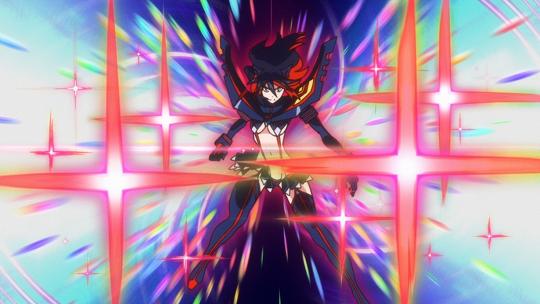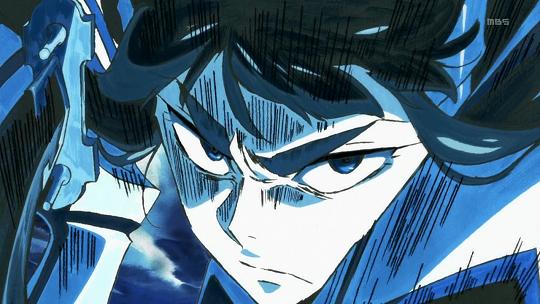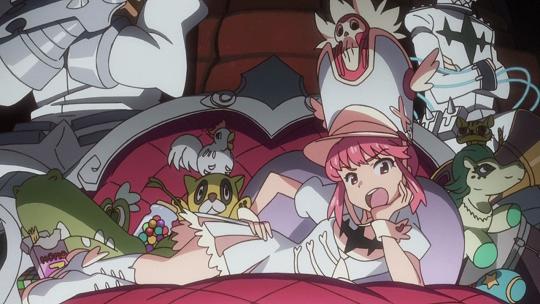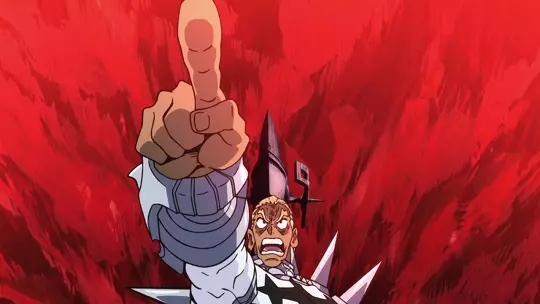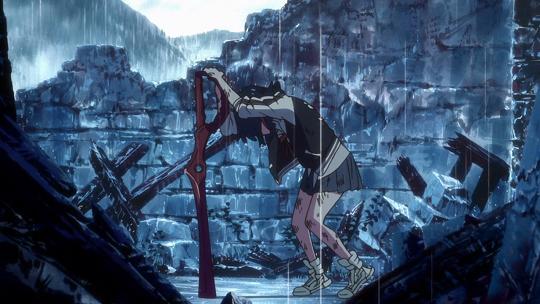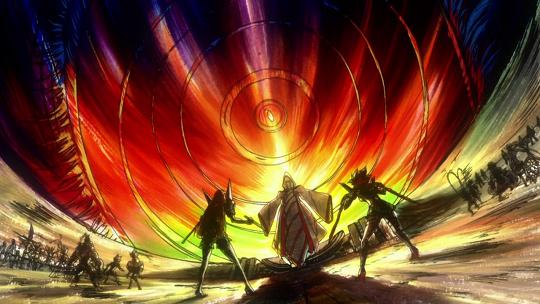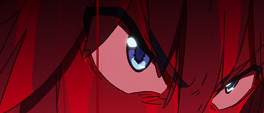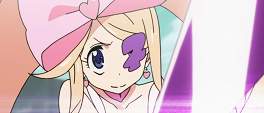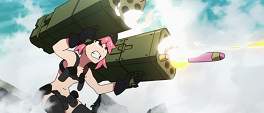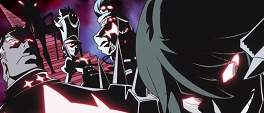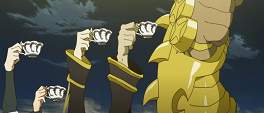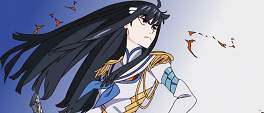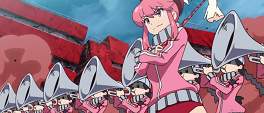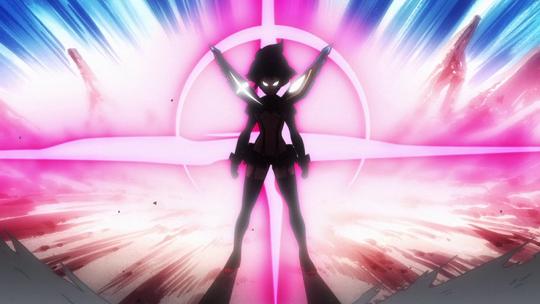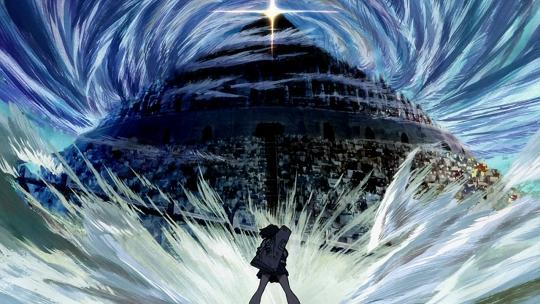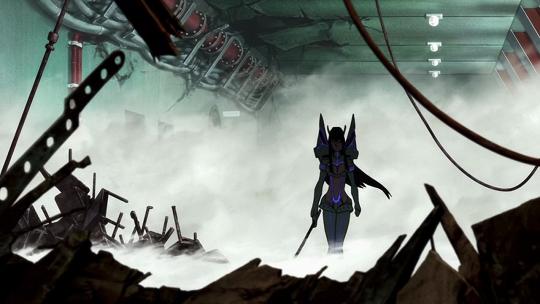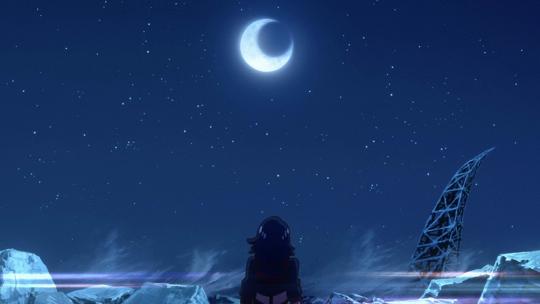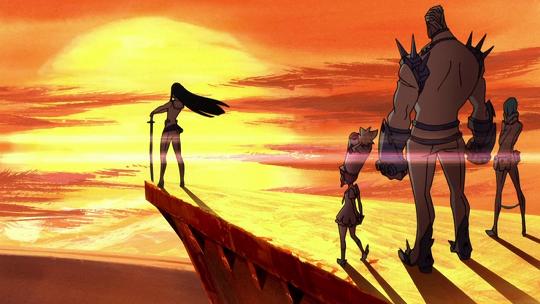Approaching Trigger’s Kill La Kill critically is a daunting task. It has been a divisive series since its first episode and the scrutiny it has been placed under by fans even now, weeks after its last episode has aired, means that there are so many arguments and debates that there is an unspoken expectation to fall on one side of the fence. Is the series feminist or misogynist? Does it have character development or just caricatures? It is a narrative wasteland or stylistic grab bag? Better or worse than Gurren Lagann?
That last point is one of a number of elephants in the room when it comes to this series, thanks in no small part to it being plastered over the initial marketing material, sharing the same director - Hiroyuki Imaishi - and a multitude of staff including writer Kazuki Nakashima. Studio Trigger’s inception is well documented, but suffice it to say that the production team and only their second original creative effort after Little Witch Academia means that Kill La Kill started with the most fearsome of challenges: expectation.
It is the grand daddy of hurdles that any anticipated creative work must either leap with effortless grace or ignore completely to silence detractors in the ignominious echo chamber of the internet. It’s telling that within three episodes many were decrying it for a panoply of sins from sexism to saving anime and all points in between. Those episodes, admittedly, are craggy and don’t speak to the pedigree behind them because, fundamentally, this will always be Trigger’s Kill La Kill, Hiroyuki Imaishi’s Kill La Kill or even Kazuki Nakashima’s Kill La Kill. It is a series with such a strong tie to its creators that it almost can’t help being polarising: you don’t get to be a known entity, a named creative, by playing to the crowd.
Except that’s what a lot of Kill La Kill feels like if you’ve seen Gurren Lagann and, worse of all it, feels like a lesser version of it. TTGL’s first act is a statement of purpose that it isn’t going to pull its punches and that the thematically consistent spiraling of scale will continue: by virtue of “build a bigger robot” you eventually get to go galaxy juggling with the antagonist. More specifically though it established a strict system of oppression, first by Lordgenome then by the Anti-Spirals - the core team are never anything but on the back foot. Kill La Kill reveals its super weapon from the getgo, and despite evolutions in its utility, it is still an overpowered instrument more or less without equal. Subsequently beyond the opening few, none of the scuffles protagonist Ryuko faces hold any kind of drama or suspense, relying instead on the escalating insanity of her enemies and the blunt force ways in which she dispatches them. She is of course the underdog, facing off as she is the white gloved iron fist of Satsuki and her fascist police state of a school.
Yes the root of many of the series’ terms lie within English / Japanese homophones - fashion / fascim, kill / kiru / to wear etc. It’s a quirky enough touch and one that is echoed by the firecracker Mako’s regular interludes that frequently and, very literally, animate what is being said. But it speaks of the kind of thinking that went into the production when the genesis of your project was a word pun; even more worrisome when combined with the multiple rewrites the screenplay apparently suffered from. It’s not the only questionable aspect of the machinery behind the curtain though: just flicking through the possible homages and references to other media, even just other anime, sprinkled throughout like confetti would have you believe there was an entire team dedicated to just weaving them into each episode. You aren’t required to understand or even twig they’re there to appreciate the series, but it’s an indication of heritage and perhaps a plaintive cry to times past when anime was different.
Like its myriad themes and references, it’s difficult to know exactly what Kill La Kill is desperately trying to say, only that it is trying to say it. For instance there’s the prevalent theme of fashion being an indicator of status in the most bourgeois of terms, or clothes being part of the ascendancy of humankind from animals, or clothing being a form of power for those willing to risk themselves for it. There’s the omnipresent school with its gargantuan concrete walls ruled over by the rich princess, or turning the usual message of school clubs being a vital part of a pupils life to being a zany and oppressive force against the students, or even the direct link between success in school and success in life. Or there’s the combination of both of them with the typical sailor schoolgirl uniform being a symbol of power and youth but that ends bittersweet in that every girl must eventually give that up. Then there’s the big ‘isms: feminism and sexism.
Many of those who pilloried the series in its early days for the representation of females and, some would say, grotesque way Ryuko and Senketsu “met” will find little to combat that the further the series advances. Similarly those who saw it as an extension of third wave feminism’s sex-positive outlook won’t see much to detract from that. Between these extremes there’s the even greyer area that encompasses fan-service, audience apathy and lurching between opinions on objectification and sexualisation. It’s complicated subject matter and its nuances and more far reaching implications demand a fuller space for exploration; the point being that Kill La Kill may or may not be saying any of these things, it just doesn’t say them with enough clarity or conviction to rise above the raucous clamour. The sheer amount of references and themes whether imagined, emergent or purposeful, dilutes all of them down until it becomes just a messy and sometimes contradictory grab bag.
When faced with that deluge of ideas and influences it’s easy to switch to simple reductivism. In this case you have the girl, Ryuko Matoi, hot-blooded and brimming with molten fury, facing off against Satsuki Kiryuin, fierce, ruthless and accomplished. Rebel meet authority. There’s a lot of decoration around that of course: Ryuko is out to find who murdered her father, Statsuki is looking to expand her power base, and scurrying around them both are the Elite Four whose unwavering devotion to Satsuki puts Ryuko’s only friend, Mako Mankanshoku, to shame. Except they would if she weren’t the beating emotional heart of the series. Earnest, borderline narcoleptic and just the right side of crazy she gloms on to Ryuko when she first roars into the plot and provides some welcome levity, joy and affection. Her and the Elite Four sometimes feel like the real stars by being as outlandish as the series wants to be. It certainly doesn’t come from Ryuko whose impetus - finding her father’s killer - waxes and wanes like the phases of the moon, while Satsuki’s mid-series shift of allegiance finally breaks her infuriating holier-than-thou facade but turns her into a steeple-fingered “all according to plan” wunderkind.
That absence or paucity of character development is what many have levelled as Kill La Kill’s most prominent failing. It’s true that you come out of the series with little more knowledge or insight into the characters than you went into it with. Even the antagonist Ragyou is played to such maniacal lengths that its surprising the scenery lasts the amount of chewing she does on it. It’s a symptom of the structure the series adopts though, preferring blood and thunder to quiet contemplation. Even in aggregate Ryuko’s motivations are difficult to scry, thanks primarily to some repeated, late stage mind control sub-plots - tedious at the best of times - and moments like her saving Mako or being trapped in a reverie of regret are too few and far between. Instead we get the extended fight scenes, grand episode-spanning tussles with eyecatches and posturing galore. And for the most part they work.
Certainly you can joke that most battles are won through a combination of shouting and reliance upon friendship but the loud, frenetic bedlam that most fights devolve into is an awful lot of fun to watch. They’re bombastic and predictable and feel like two diametrically opposing forces colliding, destroying stone and edifice with reckless abandon. And while they’re going on, it makes you forget about the nitpicks that come all too easily during the peaceful moments. The animation is a showcase of so many different techniques, some budget saving, some gloriously lush and often just fluid enough to paper over the well composed but fundamentally static shots. It certainly doesn’t hurt the boundless imagination on display with a rogues gallery of character designs and a keen eye for colour and lighting - the sometimes obnoxious use of god rays notwithstanding. This unfortunately doesn’t extend to the setting that although ostensibly taking place on a modern day earth, frequently opts for badlands chique, the grey obelisk of the school and ramshackle town around it feel identical to the neon Osaka and it isn’t until brief glimpses of other cities on earth that we get a sense of place.
Elsewhere in the production Hiroyuki Sawano’s soundtrack is suitably pounding and sees the return of Aimee Blackshleger and Cyua from his work on the grandiose Attack on Titan score. It works for the high octane thrill ride fights but, like Attack on Titan, lacks consistency with duds like Suck Your Blood and there isn’t enough to accompany less chaotic scenes. The signature track, Before My Body is Dry, is fitting and makes great use of Mika Kobayashi despite some lacklustre lyrics, but equally so the second opening, ambiguous, by Garnidelia has enough energy to prime the audience for what’s to come.
All of this is a roundabout way of saying that I had a good time with Kill La Kill.
I enjoyed the improbable and ever changing sizes of Gamagoori as much as I enjoyed the obvious romantic overtures between him and Mako - magnified a thousand fold in the endless aqueduct of fan art. I liked the deprecating and scathing voice of Nonon just as much as I liked the giggling faux innocence of Nui. I loved the utter absurdity of Ragyou’s rainbow hair and the determined devotion of Mako. I could enjoy all of these things perhaps because I was largely isolated from the scrutiny and tide of opinion that only revealed itself to me upon the series’ close when the dust had settled and the fires now embers. Kill La Kill isn’t just one thing to all people and now exists firmly in the public consciousness, representative of wildly different things to different people; that doesn’t mean that it doesn’t have a feminist message (positive or negative) or an opinion on fashion, more that they didn’t ever seem potent enough to be of worth.
Beyond all of the arguments pertaining to what Kill La Kill means or depicts or what it is a harbinger of is a David and Goliath story, a story about family and the legacy of parents, a story about chutzpah and indomitable spirit, about magical girls and bondage monsters. No one merit excuses the myriad of flaws or perceived slights that the series has in spades; it’s a question whether you can overlook them - and if you feel vehemently enough about an issue then the answer is likely no. There is great, breathless fun to be had here and your enjoyment of it (or lack thereof) will likely hinge on the breadth of your forgiveness or naivete of context.
